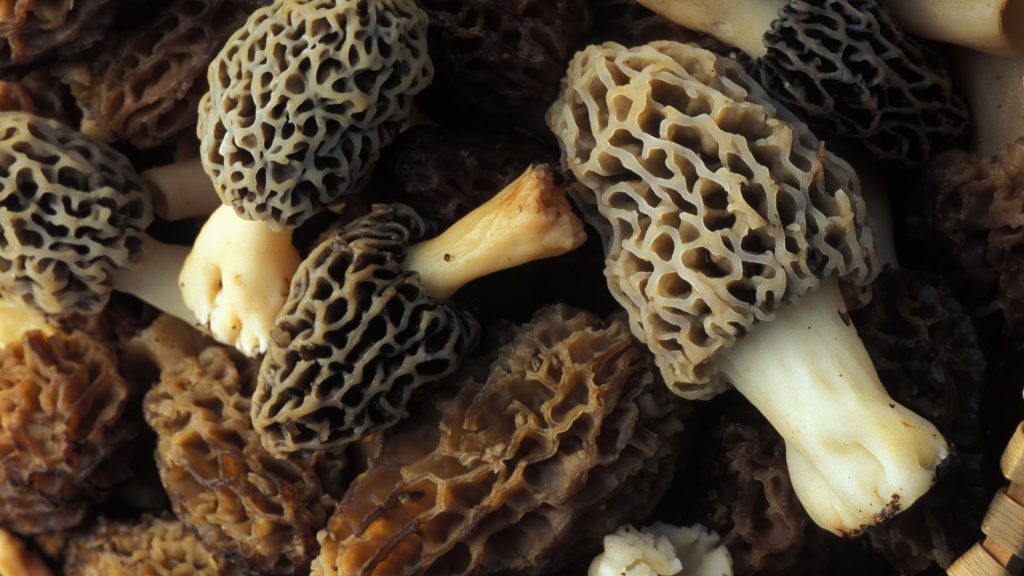 Beloved by chefs, the morel can make an ordinary meal special—or a special meal sublime.
Beloved by chefs, the morel can make an ordinary meal special—or a special meal sublime.
As plant-based entrées are embraced by the haute cuisine scene, there is one particular mushroom top chefs and diners love to see take center plate— morels. These darlings of French cooking have been called “the sacred mushroom” because of their powerfully woodsy and nutty flavor. Even those who typically find mushrooms to be too slippery or slimy can’t resist morels’ meaty texture.
Morels look more like sea creatures than the typical button-capped forest fungi, such as Portobello and cremini. They have a distinctive, honeycomb-like conical body, swirling pits and ridges.
The luxurious morel, or morchella, is closely related to the truffle; like the truffle, it is the fruit of a fungus that flourishes in moist woods and forests. They are difficult to cultivate, making them a prize for many chefs—their relative rarity adds to the appeal of these shrooms. The morel industry is truly wild—morels are not farmed, but foraged in nature. Like tulips, they are harbingers of spring and best enjoyed fresh between March and May. They also can be dried and stored to be savored during the summer, fall and winter.
Because of the complex, symbiotic relationship between morels and the surrounding trees and forest life, the ideal growing conditions are difficult to replicate in an artificial environment. Morels thrive in moist soil—often under fallen trees—in woods or forests. They have been found in all 50 states, but Michigan and other Midwest states are especially morel-rich. South facing hillsides are favored and sites of recent forest fires also are good bets for finding this variety of mushroom.
Throughout history, culture and art, mushrooms have been portrayed as delicious, magical, intoxicating and sometimes even deadly. This is also true for the precious morel. The delicacy’s close, similar looking cousin, the “false morel,” can be highly toxic and in some cases, even lethal. To avoid reenacting a poisonous love scene out of The Phantom Thread, it is wise to leave the foraging to the professionals.
In addition to tasting good, these fabulous fungi are healthy. They contain significant amounts of iron, copper, manganese, vitamin D and more. Plus, they’re loaded with antioxidants and are high in both protein and fiber.
Looking for a way to enjoy these superstar shrooms this season? Chef Geoffrey Zakarian, a 2011 winner on the Food Network’s The Next Iron Chef, recommends slowly cooking fresh morels over low heat in a bed of shallots livened up with a splash of Madeira wine, a dab of salted Irish butter and a sprinkle of fresh tarragon leaves. Alex Guarnaschelli, Iron Chef America 2012 winner and executive chef at New York City’s Butter restaurant, likes to first sweat some minced shal-lots that have been generously buttered and salted before adding the morels and salting again. She says not to stir; instead, allow them to sweat on low heat for about 10 minutes. Add in some dry vermouth and slowly simmer over low heat until the liquid evaporates. Transfer to a baking sheet and let cool. Heat a sauté pan, add butter and let it brown before adding the morels and allowing these to brown as well. Add a squeeze of lemon.
The morel of the story? You can search out—or create—many more recipes that bring out the marvel in morels.
THE HUNT: These mushrooms require very specific growing conditions, and finding them has become almost a competitive sport. But forager, beware! Before heading out, thoroughly educate yourself by reading up on distinguishing characteristics to identify them—and looking at photos. Check for a distinct cap, and remember that a true morel will be hollow from inside the cap tip to the stem bottom. DON’T take any chances, especially if you’re a novice morel hunter. And we can’t emphasize this enough: Newbies should always go with an experienced hunter who will show them the ropes and vouch for the safety of their finds. THE HARVEST: You can take the uncertainty and danger out of the experi-ence by growing and cultivating your own fresh—and safe—stash of morel mushrooms. There are several kits on the market. Check out The Morel Hab-itat Kit , which supplies you with seeds to grow pounds of morel mushrooms in your own earth-friendly, sustainable and organic perennial morel mush-room garden.
THE PREP: Thoroughly clean your morels with repeated soaks in cold water. Brush off any lingering soil and, to make sure you get rid of any persistent critters that may be lingering, try adding a splash of vinegar to the water. To freshen up dried morels, simply soak them in water for 15 to 20 minutes or until the mushrooms are tender (soft, not mushy). Then presto, they’re ready for preparation! Be sure to keep the soaking liquid, as it’s packed with flavor and can be used as a sauce, a soup or a flavoring for a risotto.

